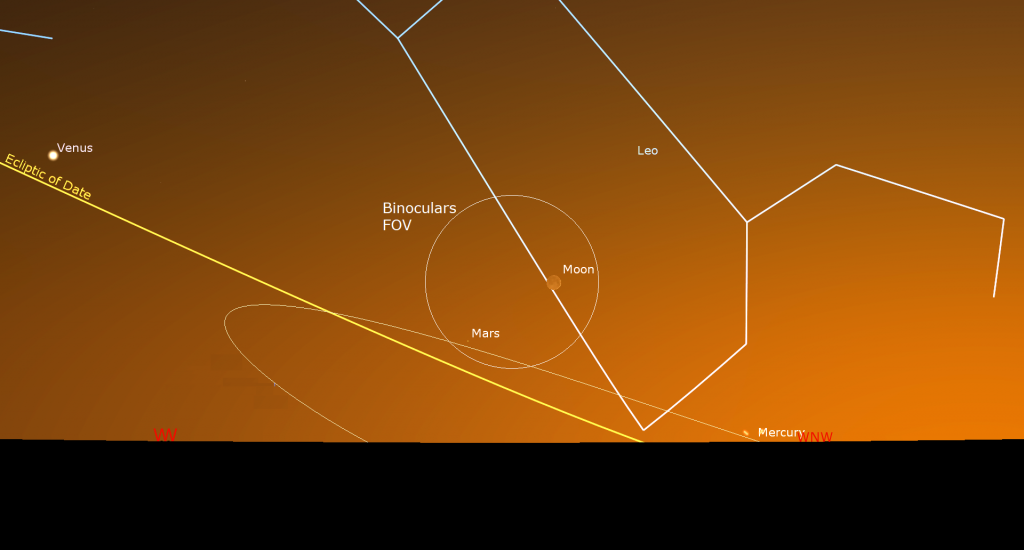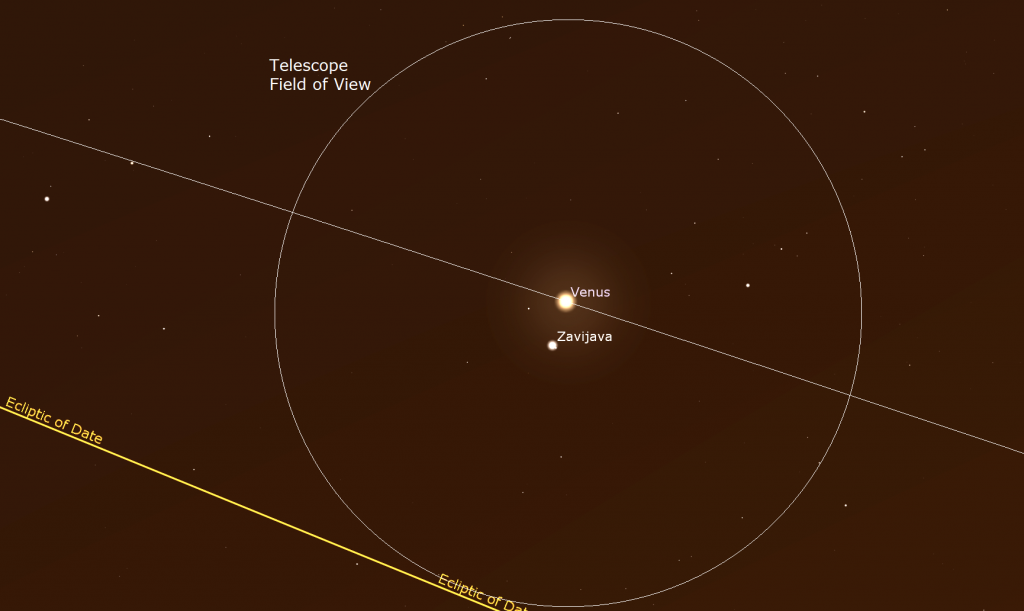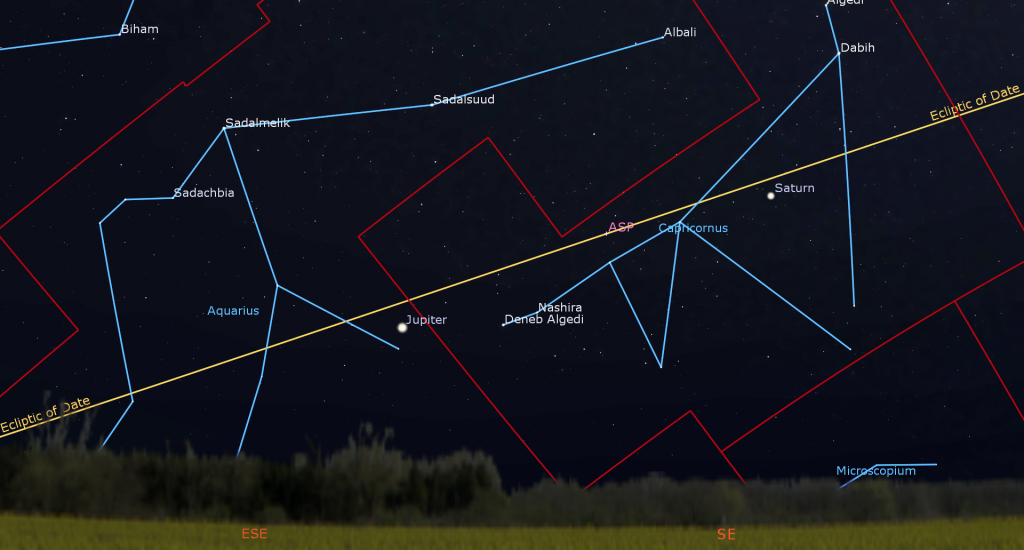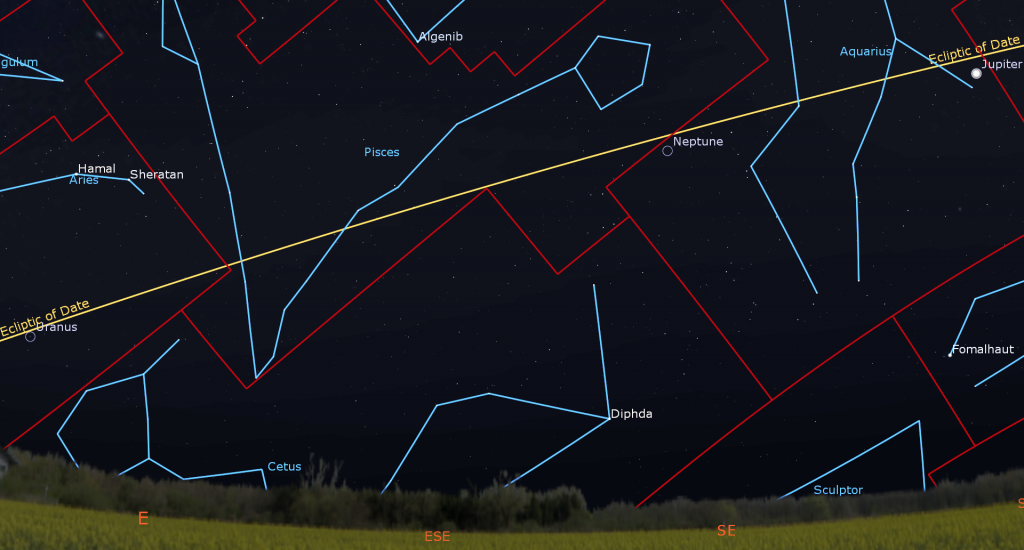The Perseids Peak Mid-week, the Moon Passes Planets in Evening, and Gas Giants Gleam Overnight!

This amazing composite image by my friend Bill Longo of Toronto was captured in 2015. The International Space Station pass was part of his imaging plan. But the Perseids Meteor shower peak also delivering an aurora borealis (greens and purple) was pure luck!
Hello, Perseids Enthusiasts!
Here are your Astronomy Skylights for the week of August 8th, 2021 by Chris Vaughan. Feel free to pass this along to your friends and send me your comments, questions, and suggested topics. You can also follow me on Twitter as @astrogeoguy! Unless otherwise noted, all times are expressed in Eastern Time. To subscribe to these emails please click this MailChimp link.
I can bring my Digital Starlab portable inflatable planetarium to your school or other daytime or evening event, or teach a session online. Contact me through AstroGeo.ca, and we’ll tour the Universe, or the Earth’s interior, together!
The moon will return to view in the evening sky this week as it glides from new to First Quarter. That early-setting moon will leave skies dark worldwide for the fantastic Perseids Meteor Shower, which will peak on Wednesday and Thursday night. Although Mercury and Mars will be tough to see over the western horizon, we can easily enjoy bright Venus, Jupiter, and Saturn. Read on for your Skylights!
Perseids Meteor Shower
The prolific Perseids Meteor Shower, a worldwide event, will reach its peak during mid-day in the Americas on Thursday, August 12. That means that the time to see the most Perseids meteors in North America will be the hours before dawn on Thursday morning, when the shower’s radiant in Perseus will be highest in the northeastern sky. Although fewer meteors are seen before and after the peak, skywatchers can also expect to see plenty of meteors on Wednesday, Thursday, and Friday night. Plan your viewing with an eye to the weather forecast. It’s better to see fewer Perseids on a clear night earlier this week than to not see any if it’s cloudy on Wednesday-Thursday.

Meteors showers can be spoiled by moonlight. Fortunately, the moon will follow the sun down after dusk on this year’s peak nights, leaving the overnight sky nice and dark around the world. Next year the moon will be just past full on august 12. In 2023 it will be approaching new.
The source of the Perseids material is thought to be a 133-year-period comet named 109P/Swift-Tuttle. The active period for this shower is July 13 through August 26, so keep an eye out for them beyond this week. This shower is known for producing 60-80 meteors per hour at the peak – many manifesting as bright, sputtering fireballs! Some leave “smoke trails” that dissipate in a few minutes.
Meteor showers are events that re-occur on the same dates every year when the Earth’s orbit carries us through zones of small particles left behind by multiple passes of periodic comets. (The analogy would be the material tossed out of a dump truck as it rattles along. The roadway gets pretty dirty if the truck drives the same route a number of times!) Over time, the dust-sized and sand-sized (and sometimes larger) particles accumulate and spread out into an elongated, tube-shaped cloud in interplanetary space.
When the Earth plows through the cloud, the particles are caught by our gravity and burn up as they fall through our atmosphere at speeds on the order of 200,000 km/hr. The friction caused by grains moving that quickly through the air generates intense heat that ionizes the air – producing the long glowing trails we see. The duration of a meteor shower depends on the width of the particle cloud – and therefore how long Earth takes to pass through it. The shower’s intensity depends on the type of particles in it, and on whether we pass through the densest portion, or merely skirt the edges. Not surprisingly, a shower’s performance can vary from year to year.
The nickname for meteors is “shooting stars” or “falling stars”, but they bear no physical connection to the distant stars. The action is taking place 100-200 km over your head and within Earth’s blanket of atmosphere. All of your favourite constellations will look the same as ever at the end of the shower!

While visible anywhere in the night sky, the meteors will appear to be travelling away from a location called the radiant. The Perseids’ radiant sits in northern Perseus, near its border with Camelopardalis (the Giraffe) – so Perseus gives this shower its name. The radiant is low in the northeastern sky during mid-August evenings – and nearly overhead by dawn. Meteor showers are strongest before dawn because that’s the time when the sky overhead is plowing directly into the oncoming debris field, like bugs splatting on a moving car’s windshield. When the radiant constellation is overhead, the entire sky down to the horizon is available for meteors. When it’s low, many of the meteors become hidden below the horizon.
To see the most meteors, try to find a safe viewing location with as much open sky as possible. If you can hide bright lights behind a building or tree, that will help. You can start watching as soon as the sky is dark. That’s also a good time to catch the rarer, very long meteors produced by particles skipping across the Earth’s upper atmosphere. Don’t worry about watching the radiant. Meteors in that part of the sky will be heading directly towards you and will have very short trails.

Bring a blanket for warmth and a chaise to avoid neck strain, plus snacks and drinks. Try to keep watching the sky even while chatting with friends or family – they’ll understand. Call out when you see one; a bit of friendly competition is fun!
Don’t look at your phone or tablet – its bright screen will spoil your dark adaptation. If you must use it, turn the brightness down, or cover the screen with red film. Disabling app notifications will reduce the chances of unexpected bright light, too. And remember that the narrow fields of view that binoculars and telescopes have will not help you see meteors.
The Southern Delta Aquariids meteor shower, caused by the Earth passing through a cloud of tiny particles dropped by a periodic Comet 96P/Machholtz, will be tapering off until August 23. Those meteors will appear to travel away from that shower’s radiant, in Aquarius (the Water-Bearer), which sits in low in the southeastern sky during evening. Good luck!
The Moon
Following its new moon phase this morning (Sunday), our natural neighbour will return to shine in the western sky after sunset this week from everywhere on Earth, except the polar regions. The moon will also visit Mercury, Mars, and Venus. By mid-week, the moon will have waxed enough to spot it in the daytime afternoon sky, well to the left (celestial east) of the sun.
By the time the sun drops below the west-northwestern horizon tonight (Sunday), the moon will have already moved a small distance to its east. That might let you glimpse its extremely thin crescent poised just above the horizon, in a barely darkening sky, just before it sets. Observers at southern latitudes, where the ecliptic and the moon’s orbit will be more vertical, will have a better chance. (Seeing such an extremely young moon is an astronomer’s bucket list item!) Little Mercury will be sitting a few finger widths to the moon’s left (celestial southeast), too. But don’t search with binoculars until the sun has completely disappeared.
The moon will wax in illuminated phase and increase its angle from the sun every night this week. It might still pose a challenge to find on Monday evening, since it will be hidden behind trees and buildings – but viewing the moon will become easy from Tuesday onward. If you do spot the moon on Monday, look for the faint dot of Mars shining a few finger widths to the moon’s lower left (or 3.5° to the celestial south).

The rest of the week will be perfect for viewing the moon with unaided eyes or under magnification. It’ll shine in the southwestern sky all evening long, and the zone along the terminator – the line that separates its lit and dark hemispheres – will look spectacular. That’s because the sun is just clearing the moon’s eastern horizon along that line, and the sun’s near-horizontal rays cast long shadows from every elevated feature. The terminator slides west as the moon’s near side fills with light each night, highlighting new strips of the moon’s terrain. Keep your telescope handy!
On Tuesday night, the 7%-illuminated moon will shine a palm’s width to the right (or 6.5° to the celestial northwest) of the extremely bright planet Venus. On Wednesday evening, the orbital motion of the moon will shift it a similar distance to Venus’ upper left (celestial east). Wednesday night’s sky will be getting dark before the moon sets, allowing you to see the stars of Virgo (the Maiden) nearby.
The moon will travel through the Maiden’s stars until Friday night, end then spend the coming weekend in Libra (the Scales). On Saturday the nearly half-illuminated moon will rise after lunch hour and set around midnight. Look for Libra’s 2nd brightest star Zubenelgenubi shining very close to the moon. A bit of magnification will reveal that Zubenelgenubi is actually two stars – a double star!
Zubenelgenubi’s name derives from the Arabic expression for “the Southern Claw”, referring to next-door Scorpius, which used to be a much larger constellation! The slightly brighter star located about a fist’s diameter above it is Zubeneschamali “the Northern Claw”. The moon will end this week shining just to the west of the scorpion’s three remaining claw stars, the up-down (north-south) arc of white stars named Acrab, Dscubba, and Fang. I’ll post a tour of the scorpion later this summer.
The moon will complete the first quarter of its journey around Earth on Sunday, August 15 at 11:19 am EDT or 15:19 Greenwich Mean Time.
The Planets
As I alluded to above, speedy Mercury will follow the sun down in the northwestern sky this week. The planet will shine there until early next month – but the canted-over angle of the ecliptic will prevent Mercury from getting high enough to see easily from northerly latitudes. This will be the best showing of the year for observers living in the tropics and farther south.
Even though the moon will visit Mars on Monday night, twilight and hazy skies near the west-northwestern horizon will make seeing the magnitude 1.83 planet very difficult. Like Mercury, Mars’ geometry favours southerly observers.
That leaves Venus! Even though our hot sister planet is also stuck near the tilted ecliptic, its magnitude -3.9 intensity is more than enough to catch your eye every night. Expect to see Venus shining a generous fist’s diameter above the western horizon starting at about 9 pm local time (and earlier from more southerly locations). It will set before 10 pm local time – just as the stars begin to come out. When viewed in a backyard telescope Venus will exhibit a smallish disk and have a somewhat squashed shape. That is because it’s only 80%-illuminated. Aim your telescope at Venus as soon as you can spot the planet in the sky (but ensure that the sun has completely disappeared first). That way, Venus will be higher and shining through less distorting atmosphere – giving you a clearer view.

On Friday evening, Venus will pass only 7 arc-minutes above (celestial north of) a medium-bright star named Zavijava or Beta Virginis, close enough to share the eyepiece of a backyard telescope. Venus will be far brighter than the star.
Look for Saturn and Jupiter shining in the southeastern sky after dusk. They’ll cross the sky together all night long and set in the west-southwest before sunrise. Yellowish Saturn will lead the way, with whitish, sixteen times brighter Jupiter following on its left (celestial east). Watch for the Milky Way and the teapot-shaped stars of Sagittarius (the Archer) sitting several fist diameters off to Saturn’s right (celestial west).

The Anti-solar Point, the spot in the sky that is directly opposite the sun right now, is about midway between those two gas giants and among the stars of Capricornus (the Sea-Goat). Saturn had its opposition last week, and Jupiter will have its turn next week. That means that both planets are brighter in the sky and look larger in telescopes because Earth is closer to them this month. Unfortunately, planets that reach opposition during the summer never climb very high in the sky. Over the next handful of years their opposition dates will shift into autumn, when they’ll make better observing targets.
Saturn’s axial tilt of 26.7° (a bit more than Earth’s) lets us see the top of its ring plane, and allows Saturn’s brighter moons to be distributed all around the planet. During this week, Saturn’s largest and brightest moon Titan will migrate counter-clockwise around Saturn, moving from the lower left (celestial southeast) of Saturn tonight to the upper right (celestial northwest) of the planet next Sunday. (Remember that your telescope will probably flip the view around.) How many moons can you see?
Jupiter is positioned two fist diameters to Saturn’s left (or 19° to the celestial east), amidst the stars of Aquarius (the Water-Bearer). Binoculars and small telescopes will show you Jupiter’s four large Galilean moons named Io, Europa, Callisto, and Ganymede. Since Jupiter’s axial tilt is only 3°, the moons are always strung like beads along a straight line that passes through the planet. But their arrangement varies from night to night.
For observers with good telescopes in the Eastern Time Zone the Great Red Spot (or GRS) will be visible crossing Jupiter on Monday and Saturday evening, late on Wednesday night, and before dawn on Monday, Wednesday, and Saturday morning. From time to time, the small round black shadows cast by Jupiter’s Galilean moons become visible in amateur telescopes when they cross (or transit) the planet’s disk. Europa’s shadow will transit with the GRS on Wednesday from 10 pm to 12:50 am EDT. That same night, you can watch the little dot of Io wink out as it enters Jupiter’s shadow at 10:41 pm EDT! On Thursday night, Io’s shadow will complete a passage at about 10:15 pm EDT, followed a few minutes later by Io itself moving clear of the planet’s disk.

On the evening of Sunday, August 15 observers with telescopes across Asia can watch three of the small black shadows cast by Jupiter’s moons as they cross the planet’s disk in a complex dance. At 11:42 pm Japan Standard Time (or 14:42 GMT), Ganymede’s shadow will move onto Jupiter, joining Callisto’s shadow. They’ll appear together for about 10 minutes until Callisto’s shadow completes its own transit at 11:52 pm JST. At 12:08 a.m. Ganymede itself will begin to move onto Jupiter, and at 12:16 am JST (or 13:16 GMT) Europa’s smaller shadow will appear at Jupiter’s limb. The two shadows will cross Jupiter until 3:20 am JST (or 18:20 GMT). In the meantime, Europa’s faster-moving shadow will overtake and merge with Ganymede’s shadow for several minutes surrounding 2:24 am JST (or 17:24 GMT).
Dim, blue Neptune is located near the border between Aquarius and Pisces (the Fishes) – about 2 fist diameters to the left (or 24° to the celestial east) of Jupiter. It rises at about 9:45 pm local time and reaches peak visibility halfway up the southern sky before 3:30 am local time. Magnitude 5.8 Uranus is bright enough to see with binoculars and backyard telescopes, even near cities. This week it will rise at about 11:30 pm local time. It will be parked below Hamal and Sheratan, the two brightest stars in Aries (the Ram), all year long.

Aquila the Eagle
If you missed last week’s tour of the venerable constellation of Aquila (the Eagle), I posted it here.
Public Astro-Themed Events
Every Monday evening, York University’s Allan I. Carswell Observatory runs an online star party – broadcasting views from four telescopes/cameras, answering viewer questions, and taking requests! Details are here. Their in-person Wednesday night viewing has been converted to online via the observatory YouTube channel.
Don’t forget to take advantage of the astronomy-themed YouTube videos posted by RASC Toronto Centre and RASC Canada.
To prepare everyone for the Perseids Meteor Shower, on Wednesday afternoon, August 11 at 2 pm EDT, my friends at the Ontario Science Centre will live stream a free program about Meteors & Meteorites on their YouTube channel. Details are here.
On Thursday, August 12 from 7:30 to 8:30 pm EDT, the David Dunlap Observatory Committee of the RASC Toronto Centre will partner with Richmond Hill Public Library to live stream a free program about the Perseids Meteor Shower. Registration and details are here.
Our in-person David Dunlap Observatory Saturday night events may be suspended at the moment, but we’re still pleased to offer online programs! On Friday, August 13 from 9:30 to 11 pm EDT, join us for DDO Up in the Sky – featuring live and pre-recorded views of the night sky’s best objects captured through the telescopes of RASC Toronto Centre members. They’ll provide commentary, too. More information and the registration link can be found here. A modest fee goes to support our ongoing efforts to deliver public programs at DDO.
My free, family-friendly Insider’s Guide to the Galaxy webcasts with Jenna Hinds of RASC National will return on Tuesday, August 17 with a Gas Giant Planets Special! You can find more details, and the schedule of future sessions, here.
Space Station Flyovers
The ISS (or International Space Station) will not be visible gliding silently over the GTA until August 25, when it resumes pre-dawn passes. This week the Chinese Tiangong Space Station will make pre-dawn appearances over the GTA.
Keep looking up, and enjoy the sky when you do. I love questions and requests. Send me some!